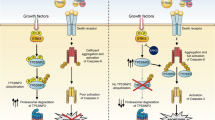Abstract
Cyclooxygenase-2 (COX-2) inhibitors are promising anticancer agents but their long-term use at high doses is associated with adverse cardiovascular events. The molecular mechanisms underlying the anticancer or toxic cardiovascular effects of COX-2 inhibitors remain unknown. Here we report that COX-2-selective celecoxib and a novel COX-2 inhibitor ON09310 upregulate death receptor 5 (DR5) and cooperate with tumor necrosis factor-related apoptosis-inducing ligand (TRAIL), the ligand for DR5, to induce apoptosis in COX-2-positive and -negative cancer cells. We also show that both agents engage GADD153/CHOP to transcriptionally upregulate DR5 expression; GADD153/CHOP is a C/EBP homologous transcription factor implicated in cellular stress response and apoptosis. Based on our results, we propose that (1) these agents appear to mediate their effects, at least in part, by engaging GADD153/CHOP to activate DR5-dependent apoptotic pathway and (2) their regulation of GADD153/CHOP and DR5 expression appears to occur independent of their COX-2 inhibitory effects. Our results also indicate that ON09310 is generally more potent than celecoxib and, at lower concentration, strongly cooperates with TRAIL to induce apoptosis. Taken together, our findings form the basis for future in-depth studies to further explore the utility of TRAIL and/or agonistic anti-DR5 antibodies in combination with low-dose COX-2 inhibitors as a rational approach for cancer prevention and treatment.
This is a preview of subscription content, access via your institution
Access options
Subscribe to this journal
Receive 50 print issues and online access
$259.00 per year
only $5.18 per issue
Buy this article
- Purchase on Springer Link
- Instant access to full article PDF
Prices may be subject to local taxes which are calculated during checkout




Similar content being viewed by others
References
Eberhart CE, Coffey RJ, Radhika A, Giardiello FM, Ferrenbach S, DuBois RN . (1994). Up-regulation of cyclooxygenase 2 gene expression in human colorectal adenomas and adenocarcinomas. Gastroenterology 107: 1183–1188.
Grosser T, Fries S, FitzGerald GA . (2006). Biological basis for the cardiovascular consequences of COX-2 inhibition: therapeutic challenges and opportunities. J Clin Invest 116: 4–15.
Gupta S, Srivastava M, Ahmad N, Bostwick DG, Mukhtar H . (2000). Over-expression of cyclooxygenase-2 in human prostate adenocarcinoma. Prostate 42: 73–78.
He Q, Lee DI, Rong R, Yu M, Luo X, Klein M et al. (2002a). Endoplasmic reticulum calcium pool depletion-induced apoptosis is coupled with activation of the death receptor 5 pathway. Oncogene 21: 2623–2633.
He Q, Luo X, Huang Y, Sheikh MS . (2002b). Apo2L/TRAIL differentially modulates the apoptotic effects of sulindac and a COX-2 selective non-steroidal anti-inflammatory agent in Bax-deficient cells. Oncogene 21: 6032–6040.
Hida T, Yatabe Y, Achiwa H, Muramatsu H, Kozaki K, Nakamura S et al. (1998). Increased expression of cyclooxygenase 2 occurs frequently in human lung cancers, specifically in adenocarcinomas. Cancer Res 58: 3761–3764.
Huang Y, He Q, Hillman MJ, Rong R, Sheikh MS . (2001). Sulindac sulfide-induced apoptosis involves death receptor 5 and the caspase 8-dependent pathway in human colon and prostate cancer cells. Cancer Res 61: 6918–6924.
Huang Y, Sheikh MS . (2006). TRAIL death receptors and cancer therapeutics. Toxicol Appl Pharmacol; e-pub ahead of print: 16 December 2006.
Liu X, Yue P, Zhou Z, Khuri FR, Sun SY . (2004). Death receptor regulation and celecoxib-induced apoptosis in human lung cancer cells. J Natl Cancer Inst 96: 1769–1780.
Marnett LJ, DuBois RN . (2002). COX-2: a target for colon cancer prevention. Annu Rev Pharmacol Toxicol 42: 55–80.
Oyadomoari S, Mori M . (2004). Roles of CHOP/GADD153 in endoplasmic reticulum stress. Cell Death Diff 11: 381–389.
Prescott SM, Fitzpatrick FA . (2000). Cyclooxygenase-2 and carcinogenesis. Biochim Biophys Acta 1470: M69–M78.
Reddy EP, Reddy MVR . (2002). B1 1-(4-sulfamylaryl)-3-substituted-5-aryl-2-pyrazolines and inhibitors of cyclooxygenase-2, US6376519 4–23.
Ristimaki A, Honkanen N, Jankala H, Sipponen P, Harkonen M . (1997). Expression of cyclooxygenase-2 in human gastric carcinoma. Cancer Res 57: 1276–1280.
Williams CS, Mann M, DuBois RN . (1999). The role of cyclooxygenases in inflammation, cancer, and development. Oncogene 18: 7908–7915.
Wilson KT, Fu S, Ramanujam KS, Meltzer SJ . (1998). Increased expression of inducible nitric oxide synthase and cyclooxygenase-2 in Barrett's esophagus and associated adenocarcinomas. Cancer Res 58: 2929–2934.
Yamaguchi H, Wang HG . (2004). CHOP is involved in endoplasmic reticulum stress-induced apoptosis by enhancing DR5 expression in human carcinoma cells. J Biol Chem 279: 45495–45502.
Zimmermann KC, Sarbia M, Weber AA, Borchard F, Gabbert HE, Schror K . (1999). Cyclooxygenase-2 expression in human esophageal carcinoma. Cancer Res 59: 198–204.
Acknowledgements
This work was supported in part by a DOD PCRP grant W81XWH-04-1-0285 and NIH grant CA86945. EPR was supported by a grant from the Department of Defence, DAMD 17-02-1-0579 and from NIH (CA 109820).
Author information
Authors and Affiliations
Corresponding author
Rights and permissions
About this article
Cite this article
He, Q., Luo, X., Jin, W. et al. Celecoxib and a novel COX-2 inhibitor ON09310 upregulate death receptor 5 expression via GADD153/CHOP. Oncogene 27, 2656–2660 (2008). https://doi.org/10.1038/sj.onc.1210894
Received:
Revised:
Accepted:
Published:
Issue Date:
DOI: https://doi.org/10.1038/sj.onc.1210894
Keywords
This article is cited by
-
Stress-induced TRAILR2 expression overcomes TRAIL resistance in cancer cell spheroids
Cell Death & Differentiation (2020)
-
Elucidation for modulation of death receptor (DR) 5 to strengthen apoptotic signals in cancer cells
Archives of Pharmacal Research (2019)
-
Caffeic acid phenethyl ester enhances TRAIL-mediated apoptosis via CHOP-induced death receptor 5 upregulation in hepatocarcinoma Hep3B cells
Molecular and Cellular Biochemistry (2016)
-
Interaktion von Anästhetika und Analgetika mit Tumorzellen
Der Anaesthesist (2014)
-
COX-2/PGE2: molecular ambassadors of Kaposi's sarcoma-associated herpes virus oncoprotein-v-FLIP
Oncogenesis (2012)



